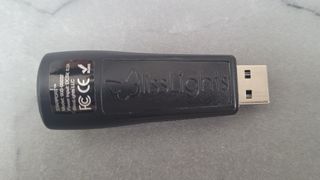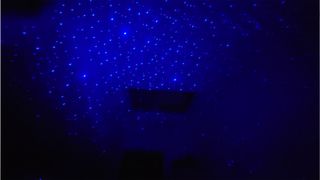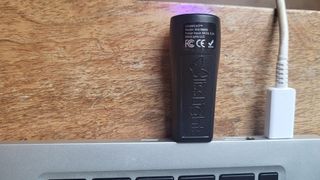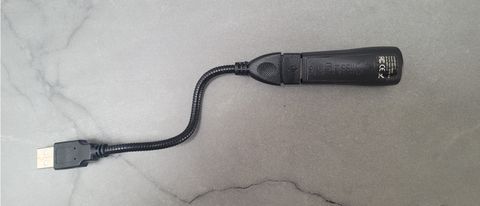Space Verdict
A nice little device for adding instant ambience to environments like parties, gaming rooms, music studios or spa rooms, but we use the term star projector very loosely.
Pros
- +
Tiny at just 65mm long
- +
Uses less than 1mW of power
- +
Lasers are bright and expansive
Cons
- -
Not recommended for children
- -
Lacks any other functionality
- -
Only one color per device
Why you can trust Space.com
The BlissLights USB Starport star projector is one of the smallest star projectors we've ever reviewed and tested. In our BlissLights Sky Lite 2.0 Star Projector review earlier this year, we concluded that the 2.0 is a handy device that creates a fun way to see and create lights that are comparable to deep space imagery and stars, albeit not scientific.
Size: 19D x 38W x 64H millimetres
Bulb Type: Class 2 Laser
Rotation: No
Sleep timer: No
Speaker: No
Projection Surface: 30 x 30 ft / 10 x 10 m
It gives the user creative control over the colors, lasers, speed and patterns thanks to its app functionality and this is somewhat paralleled in the USB Starport. We were intrigued when testing the BlissLights Starport USB star projector. It didn't seem to offer much at all in the way of functionality but still boasted over 6000 reviews on Amazon earning it a respectable 4.5 out of 5 stars, with many of the reviews raving about how good it is. We wanted to try it out for ourselves.
BlissLights Starport USB star projector: Design

- Tiny device
- Comes with a flexible gooseneck cable
- Simple enhancements would be welcomed
If you were to see the BlissLights Starport USB star projector lying on a table, you could be forgiven for thinking it was a flash drive. That is exactly how it looks. Small, discrete, inoffensive. It's just 2.5 inches (65mm) long and weighs 2.4oz (68g). It comes with a gooseneck cable, extending it by 7.2 inches (185mm). There are no buttons. One end is the USB (2.0, type A connector), and the other is the laser. To turn it on, you plug it in, and to turn it off, you pull it out.
We think it would have been a good design idea to have a keyring attachment so you can leave it with your keys to take it out and about with you, to share with friends at their parties/movie nights, etc. That might even serve as a word-of-mouth promotion for BlissLights to sell more devices if more people see it in action for themselves.
The device is made out of Acrylonitrile Butadiene Styrene (ABS), a material common in 3D printing and often found to house electronics. It has high resistance to impact and abrasion to protect the components within. We've dropped it (rather than thrown it) from various heights, which had no detrimental impact at all.
The laser is Class 2, which is considered safe for normal operation, provided you don't stare into the beam. It isn't safe for children or vulnerable people to be left with the device unattended for this reason. The model we are testing is a blue laser, but it is also available to purchase in blue or red.
BlissLights Starport USB star projector: Performance
- Lasers are very bright
- Uses next to no power
- Plug it into any USB device to power it

We were pretty nonchalant about trying this device. After all, it is a plug-in laser pointer with just one laser output, no customization options, single solid color and no movement.
However, after we'd waited for it to go completely dark, we plugged the USB 2.0 into an Anker power bank 325 and turned the power on. We were actually pleasantly surprised at the ambiance it immediately created across two whole rooms. The walls and ceiling were completely littered with blue dots of varying brightness, some bright, pinpoint and sharp, others a little dimmer and fuzzier. The projection coverage is up to a substantial 30 x 30ft / 10 x 10m.
In the daytime, the resulting display is somewhat lackluster but of course, it isn't meant to be used when it's light. Because it's charged by USB, we tested it in a laptop, power bank, and USB wall charger. The stick itself is limiting positioning-wise as it only points in one direction directly from the USB device, but once you add the gooseneck cable you can position it at whichever angle you please. The cable isn't quite strong enough to stay in position when holding the device without support. We used a peg to pinch the cable together and keep it in position. If using a power bank you can obviously also place this wherever you see fit to adjust the position and angle of the laser beam accordingly.
We had some fun moving the power bank with the laser pen attached to create some slow shutter photos, as well as teasing the cat...who loved it.
With energy costs still rising, we are all thinking of ways to 'switch off' where possible. So it may seem to be counter-productive to have extra things plugged in just to create a bit of atmosphere. However, with the starport using less than 1mW of power, the cost to run it is negligible. We do wonder why BlissLights didn't just opt for it to be battery-powered, given even a small button battery would run the lasers for hundreds of hours!
BlissLights Starport USB star projector: Functionality
- It could have been made to be more functional
- Other devices offer more features at a lower cost
- Does what it is meant to and nothing more

The strapline on the box reads 'Portable USB Star Projector'. Compared with the likes of the Sega Toys Homestar Flux, or the National Geographic Astro Planetarium Star Projector, the differences are clear. In no way does this device offer a realistic representation of the night sky, so calling it a 'star projector' isn't entirely accurate.
It does fill the room with an impressive display of blue (or green/red depending on the model) lasers. The primary purpose is to create a cool environment to enhance the atmosphere in a room. Suitable spaces we can think of include parties, games rooms, music studios, home cinemas or spa rooms.
Given the affordability of memory/storage, it would have been a bonus if this device could have been used as a flash drive/memory stick to give it an additional purpose.
We'd also like to have a button on the side of it so we could turn the lasers on and off without having to physically unplug the device from the USB 2.0 power source. You could plug it into a smart plug and use voice activation to turn the plug itself on or off to stop powering the device.
We would have also liked the ability to just the brightness of the lasers. They are very bright, so if it's a relaxing atmosphere you're trying to create, the brightness might be 'a bit much'. You could make them appear dimmer by using a wipeable marker and drawing onto the glass itself or covering it with translucent tape.
Should I buy the BlissLights Starport USB star projector?
This is a simple plug-and-play device to enhance the ambiance of a room. It lacks versatility and has minimal functionality, but if you're looking to flood a place with laser lights, this fits the bill. It covers a large area with very bright points of light, and the price is reasonable. It's best suited to those on a tight budget or who aren't fussed about moving lasers or accurate star projections. We imagine this would be most enjoyed by younger space enthusiasts and gamers who want to spice up their room with some ambient lighting.
If the BlissLights Starport USB star projector isn't for you
For devices that serve a similar purpose — to create ambiance — that do allow some creative control, consider the Encalife Atmosphere Smart Galaxy Projector that we reviewed previously.
For even greater functionality, in the form of an inbuilt Bluetooth speaker, the Encalife Ambience Galaxy and Star Projector might be a good option.
For a more educational and scientific experience, you can't go far wrong with the Segatoys Homestar Flux or the slightly cheaper National Geographic Astro Planetarium. Check out our reviews of both devices to see which would be better suited for you.
If it's only the real night sky that you're interested in, you'll want to take a read of our round-ups of the best binoculars for stargazing, best cameras for astrophotography and the best telescopes for seeing planets.
Join our Space Forums to keep talking space on the latest missions, night sky and more! And if you have a news tip, correction or comment, let us know at: community@space.com.

Tantse Walter is a photographer and adventurer that's spent seven years facilitating global adventurous expeditions. She loves getting into the nitty-gritty of sourcing and planning trips. Whether that be for astrophotography location scouting, or just for the love of exploration. Tantse enjoys taking creative, bright and bold photos of people, places, animals and the night sky. Tantse’s photos have been purchased by notable companies such as Ford and Cross Country Trains as well as an upcoming book about the songs, rituals and musical history of Capoeira.

